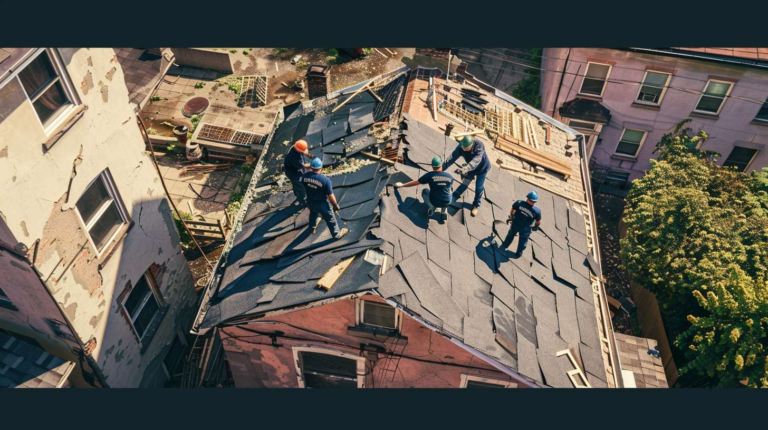Professional Flat Roof to Wall Flashing Repair & Installation
After three decades fixing roofs across Queens, I can tell you that flat roof to wall flashing is where most water damage starts. It's that critical junction where your roof meets a vertical wall - and if it's not done right, you're looking at serious problems down the road.
Look, I've seen too many buildings in Astoria and Flushing where someone tried to shortcut the flashing process. Water finds every weakness, especially with our freeze-thaw cycles here in New York. Last month alone, we fixed four different properties where improper wall flashing caused thousands in interior damage.
Understanding How to Flash a Flat Roof to a Vertical Wall
The key to flashing flat roof to wall connections is understanding that water needs two things: a path away from the building and no place to hide. When you're dealing with a flat roof meeting a wall, you're essentially creating a dam if you don't handle the transition correctly.
Here's what most people don't realize - the flashing system has to account for building movement. These buildings expand and contract with temperature changes. I learned this the hard way back in '98 when a job in Long Island City failed because we didn't allow for thermal movement. The flashing cracked within two winters.
The proper technique involves installing base flashing against the wall first, then covering it with cap flashing that extends down over the base flashing. But there's more to it than just layering materials.
Step-by-Step Process for Flashing Installation
When we approach how to flash flat roof to wall connections, we follow a specific sequence that's been refined over years of trial and error:
- Clean and prepare the wall surface - remove all loose mortar and debris
- Install a reglet (groove) in the mortar joint about 4 inches above the roof surface
- Apply base flashing that extends 8 inches up the wall and 6 inches onto the roof
- Seal the base flashing to both surfaces using compatible sealants
- Install cap flashing that fits into the reglet and extends 2 inches below
- Seal the reglet with appropriate caulk or sealant
But here's where experience matters - the type of wall construction changes everything. Brick walls, concrete block, stucco over frame construction - each requires different approaches. On brick walls, we always cut the reglet into the mortar joint, never through the brick itself. I've seen guys try to shortcut this and end up cracking bricks, which creates more problems than it solves.
Common Mistakes in Flat Roof Wall Flashing
After fixing hundreds of failed flashing jobs, I can spot the most common mistakes from across the street. The biggest one? Not extending the base flashing high enough up the wall. Code requires at least 8 inches, but in Queens with our driving rains, I go higher whenever possible.
Another mistake is using incompatible materials. Mixing different metals without proper isolation leads to galvanic corrosion. I saw this on a commercial building in Elmhurst where they used aluminum flashing with steel fasteners. Within five years, the whole system was compromised.
And don't get me started on improper lapping. Water flows downhill - seems obvious, but you'd be amazed how many installations have the flashing lapped backwards.
Material Selection for Queens Weather
Our climate here presents unique challenges for flashing on flat roof wall connections. The salt air from the East River, freeze-thaw cycles, and occasional severe storms mean material selection is critical.
For most residential applications, I prefer modified bitumen or EPDM rubber flashing materials. They handle our temperature extremes better than metal options and are more forgiving during installation. For commercial applications, we often use copper or stainless steel, depending on the existing roof system.
The sealants matter just as much. We use polyurethane sealants for most applications because they maintain flexibility through temperature changes. Silicone works well too, but only if you're sure nothing will ever need to stick to it later.
When to Call Flat Masters NY
If you're seeing water stains on interior walls near where your roof meets the wall, don't wait. Water damage accelerates once it starts, and what might be a $800 flashing repair today could become a $8,000 renovation project next year.
We've been handling complex flashing situations throughout Queens for over 30 years. From simple residential repairs to complex commercial installations, our team knows how to properly flash flat roofs to walls that will last.
Signs you need immediate attention include: water stains on interior walls, loose or missing flashing, rust stains on walls below the roof line, or ice buildup in winter at roof-wall intersections.
The Real Cost of Poor Flashing
I'll be straight with you - proper flashing installation isn't the cheapest part of a roofing project, but it's the most important. A typical residential roof-to-wall flashing repair runs $300-800, depending on the length and complexity. New installation during roof replacement might add $500-1,500 to your project cost.
But compare that to what we see when flashing fails: interior wall repairs, insulation replacement, structural damage from prolonged moisture exposure. Last year, we worked on a building in Jackson Heights where failed flashing led to over $15,000 in interior damage.
The building owner had ignored small water stains for three years. By the time they called us, the damage extended through three floors of the building.
Why Experience Matters
Here's the thing about flashing work - it looks simple until you're actually doing it. Every building is different. Wall construction varies, roof systems differ, and local conditions create unique challenges.
Just last week, we worked on a 1920s brick building in Woodside where the walls had settled over time, creating an irregular surface. A less experienced crew might have just followed the wall contours, but we knew that would create pockets where water could collect. Instead, we built up the low areas to create proper drainage slopes.
That kind of problem-solving comes from decades in the field. You can't learn it from YouTube videos or manufacturer spec sheets.
If you're dealing with roof-to-wall flashing issues in Queens, don't gamble with inexperienced contractors. Call Flat Masters NY at (917) 994-7618. We'll assess your situation properly and give you a solution that will protect your building for years to come.


